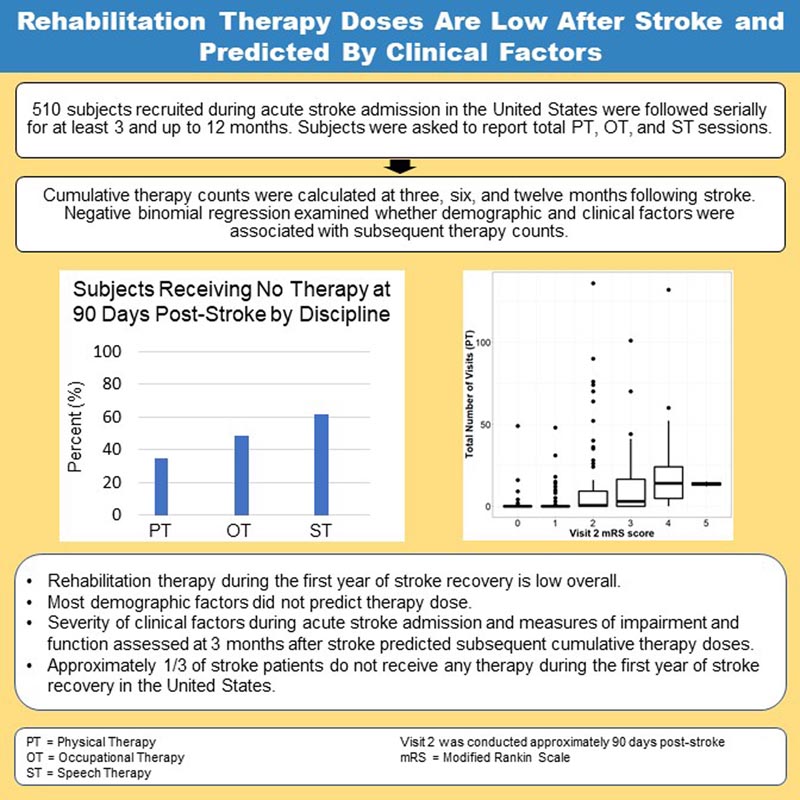Background
Stroke is a leading cause of long-term disability. Increased rehabilitation therapy after stroke is known to improve functional outcomes. This study examined therapy doses during the first year of stroke recovery and identified factors predicting rehabilitative therapy dosage.
Methods
Adults with a new radiologically confirmed stroke were enrolled 2 to 10 days after stroke onset at 28 acute care hospitals in the United States. After an initial assessment during acute hospitalization, the number of physical therapy, occupational therapy, and speech therapy sessions were determined at visits that occurred 3, 6, and 12 months after stroke.
Negative binomial regression examined whether clinical and demographic factors were associated with therapy counts. The false discovery rate was used to correct for multiple comparisons.
Results
Of 763 patients enrolled during acute stroke admission, 510 were available for follow-up. Therapy counts were low overall, with most therapies administered within the first 3 months; 35.0% of patients did not receive physical therapy; 48.8% without occupational therapy and 61.7% without speech therapy.
Discharge destination was significantly related to cumulative therapy; The percentage of patients discharged to an inpatient rehabilitation facility varied across sites, from 0% to 71%.
Most demographic factors did not predict therapy dose, although Hispanic patients received a lower cumulative amount of physical therapy and occupational therapy.
Acutely, the severity of clinical factors (grip strength and National Institutes of Health Stroke Scale score, as well as National Institutes of Health Stroke Scale subscores for aphasia and neglect) predicted higher subsequent therapy doses.
Measures of impairment and function (Fugl-Meyer, Modified Rankin Scale, and Stroke Impact Scale Activities of Daily Living) assessed 3 months after stroke also predicted subsequent cumulative therapy doses.

Conclusions
Doses of rehabilitation therapy during the first year after stroke are low in the United States. This is the first US-wide study to demonstrate that behavioral deficits predict therapy dosage, with patients who have more severe deficits receiving higher doses. The findings suggest directions for identifying groups at risk for receiving disproportionately low rehabilitation doses.
Comments
Many patients do not receive much rehabilitation therapy after a stroke, despite strong evidence that higher amounts can reduce long-term disability, according to a new UCLA-led study that followed more than 500 patients over 28 years. acute care hospitals in their first year after an attack.
Hispanic patients also received disproportionately lower amounts of rehabilitation.
The new research, published in the peer-reviewed journal Stroke, is the first US-wide study to find that patients who suffered more severe strokes received greater amounts of rehabilitation therapy, a welcome finding. “But in the big picture, the findings reinforce that too many patients are missing a golden opportunity to maximize recovery during a critical period after a stroke,” said the study’s lead author, Steven Cramer, MD. Stroke is a leading cause of long-term disability in the United States and can affect speech, memory, and mobility, among other impairments.
“In the initial weeks after a stroke, the brain is ready to undergo maximum rewiring for people to recover. "Rehabilitation therapy helps maximize this recovery, with higher doses of rehabilitation therapy helping more, but what we found in this study is that most patients receive fairly small doses of rehabilitation therapy," said Dr. Cramer, a stroke neurologist and professor of neurology at the David Geffen School of Medicine at UCLA and the California Rehabilitation Institute.
Among the key findings of the study:
- Many patients followed in this study did not receive any rehabilitation therapy after their stroke. After three months, about a third of the patients had not received physical therapy, almost half had not received occupational therapy, and more than 6 in 10 had not received speech therapy.
- Those who received rehabilitation therapy generally had six to eight sessions three months after the stroke, and between 0 and 1.5 sessions the rest of the year.
- Where patients were sent after hospitalization also mattered. Those who were discharged home had the lowest levels of rehabilitation therapy, regardless of the severity of their stroke.
- Hispanic patients received disproportionately lower amounts of physical therapy and occupational therapy.
Cramer said it is important for future research to examine the feasibility of providing higher doses of therapy to stroke patients.
The study’s other authors are Brittany Young, MD, PhD, of UCLA and the California Rehabilitation Institute, and Alison Holman, PhD, FNP, of the Sue and Bill Gross School of Nursing at UC-Irvine.















